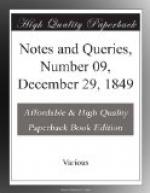[Footnote 1: Thy is pronounced as thee.]
[We have received many other communications respecting the epithet of this insect—so great a favourite with children. ALICUI and several other correspondents incline to L.B.L.’s opinion that it takes its name from a fancied resemblance of its bright wing-cases to the episcopal cope or chasuble. J.T. reminds us that St. Barnabas has been distinguished of old by the title of bright, as in the old proverbial distich intended to mark the day of his festival according to the Old Style (21st June):—
“Barnaby
bright!
The longest day
and the shortest night.”
While F.E. furnishes us with another
and happier version of the
Norfolk popular rhyme:—
“Bishop, Bishop Barnabee, Tell me when my wedding be; If it be to-morrow day, Take your wings and fly away! Fly to the east, fly to the west, Fly to them that I love best!”
The name which this pretty insect bears in the various languages of Europe is clearly mythic. In this, as in other cases, the Virgin has supplanted Freya; so that Freyjuhaena and Frouehenge have been changed into Marienvoglein, which corresponds with Our Lady’s Bird. There, can, therefore, be little doubt that the esteem with which the lady-bird, or Our Lady’s cow, is still regarded, is a relic of the ancient cult.]
* * * * *
MATHEMATICAL ARCHAEOLOGY.
Sir,—I cannot gather from your “Notes” that scientific archaeology is included in your plan, nor yet, on the other hand, any indications of its exclusion. Science, however, and especially mathematical science, has its archaeology; and many doubtful points of great importance are amongst the “vexed questions” that can only be cleared up by documentary evidence. That evidence is more likely to be found mixed up amongst the masses of papers belonging to systematic collectors than amongst the papers of mere mathematicians—amongst men who never destroy a paper because they have no present use for it, or because the subject does not come within the range of their researches, than amongst men who value nothing but a “new theorem” or “an improved solution.”
As a general rule I have always habituated myself to preserve every scrap of paper of any remote (and indeed recent) period, that had the appearance of being written by a literary man, whether I {133} knew the hand, or understood the circumstance to which it referred, or not. Such papers, whether we understand them or not, have a possible value to others; and indeed, as my collections have always been at the service of my friends, very few indeed have been left in my hands, and those, probably, of no material value.
I wish this system were generally adopted. Papers, occasionally of great historical importance, and very often of archaeological interest, would thus be preserved, and, what is more, used, as they would thus generally find their way into the right hands.




